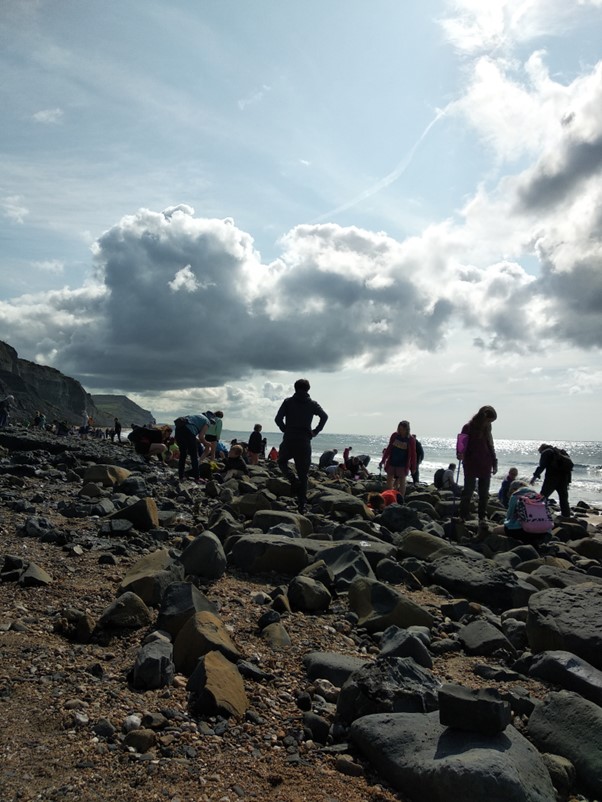
Only a few days back from Charmouth in Dorset, so I’m still demob-happy, not yet ready to contemplate the list of historical ideas I’ve got for future blogs in the dark days and long nights to come. Nor yet tackled the tangled mass of thistles and bindweed (the flowers are nice, but….) on the allotment from out of which glower yellow, obese courgettes which went berserk during our short time away. Then again, we are having summer now, (when last week we needed jumpers) probably the hottest September ever, with cars spotted and sprayed in the mornings by part of the Sahara Desert.
Charmouth. Yes. In our family newcomers used to be required to “pass the Charmouth test”. Not everybody passed. Probably because they thought we were not all there. Our daughter-in-law was prevented from meeting us for quite some time during the courtship in case she should be put off by our natural ebullience or grumpiness, take your pick. When all was deemed OK, she passed “the test” with a First. I think we did too. Since 1973, the Queen of the Jurassic Coast has been our choice of destination (give or take a Pandemic or major surgery) three or four times a year. Mostly in summer, but occasionally in the dead of winter. One time, in a bitter January or February, our youngest, Kevin, then just a small bundle, was swept high into the air by a sea-squall which developed into a hurricane. As we ran about the sands shrieking, failing to catch hold of him, the fickle wind decided it no longer wanted to play, and dropped him into the deep end of a freezing rock pool. He was quickly swaddled in all available towels and woollies and has survived to adulthood. In fact, 50 years later, he was with us last week. Why did we do this? In a word, Fossils. George, (then still known as Norman) was probably the best finder, but I was the most fanatic. Not that finding was ever easy, even in the 1970s, you’d need to go back to Mary Anning’s time for that).
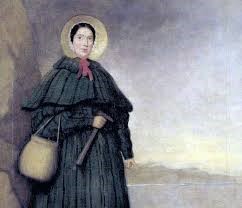
Hero: Mary Anning. 1799-1847. (Ignore the silly film about her fictitious sex-life).
We were not as talented as Mary who was cute enough in the first place to make a living selling “the stones” (which most of the local yokels thought were commonplace everywhere) to visitors; we didn’t live in the right century, or even nearby, but still, we’ve got a sideboard on which our “good stuff” is displayed. By 2023, half a belemnite without a tip is a eureka moment and as for a perfect ammonite, forget it. Of course, hope springs eternal, see the marvellous finds in the fossil museum, so you know it’s still possible. From old times we have kept bits and pieces in a trunk under our stairs superior to any you might find nowadays in a simple stroll along the beach. I felt guilty about this “reserve collection”, until I got into conversation last week with a young man, a guide in the fossil museum, a fellow enthusiast. He reassured me.
“You’ve preserved them. If you didn’t pick them up, they would have been crushed by the next tide anyway. Since 1973, eh? Well done.”
Neither of us, George nor I, can walk far now, and though we can bend down, we can’t get up again without haulage gear. The days of our leaving our snug sleeping bags at four in the morning so as “to beat the casuals” and reap the harvest deposited by the outgoing tide, are now the stuff of tearful nostalgia. Triumphant and mud-spattered, it was the best free fun you could get, especially with three infants aged three to five stoically trudging along in our crocodile in their little Wellingtons. This year we were three generations, me and George, Kevin, and Evan aged 16, parents, grandparents, uncle and nephew, plus the dog. Kevin introduced Evan to morning bird watching, and most evenings the pair of them talked music, way above my head, until late. Kevin won at Scrabble three nights in a row, though the third degenerated, into raucous misbehaviour more appropriate to junior school. The Kev calmed his nerves by checking the tiles in two sets of Scrabble, one belonging to the house, and ours, antiquated, with scores of bygone triumphs saved for posterity. He discovered tiles missing from both sets and though nobody suggested the rubber was null and void, he made a note of the missing letters on both tile bags. I have no recollection of losing any tiles, but it’s clearly time for a modern set.
Kepler, a black Labrador, with starving-puppy eyes, the third of our dogs to enjoy Charmouth, is adept at the wild swimming, as was his previous brother, Patch, a Lab-Collie cross, with pointy ears and a white vest, but the first of their line, a poodle, Aramis, never got his feet wet. Poodles are supposed to be “Water dogs” – Huh? Ari would daintily tiptoe round even the smallest puddle. He was more of a Sherpa, but that’s a different story. Anyway, Kepler, George’s “other son”, usually did his daily swims at Charmouth but one day we went to Lyme Regis. Kev made a false prophecy, “It’s about to clear up” and off we set.
Whilst Kepler swam in the sea off Monmouth Beach and the others watched in the rain, for the first time in all these years, I read the history board. I knew that in 1685, it was the place the Duke of Monmouth landed at the start of his infamous crusade to take England from his uncle, James II. School History is all about the toffs, but today, as is usual for me, it was the fate of one of “the little people” which caught my eye. Monmouth of course, was too posh to take the oars himself so he was rowed ashore by a Charmouth fisherman who shouldn’t have been there at all. But Fate had it in for the oarsman. Big History is the march through Devon, Somerset and Wiltshire, with Monmouth gathering up his forces from the ploughboys of the shires, eager for adventure, who were so poorly equipped their armoury consisted mainly of pitchforks. Without any research aids with me, the story of the fisherman had to wait until I returned home. I did, however, have another project in mind. I had long been intrigued by the man in the large tombstone in Charmouth churchyard whose life ended when he was killed in a duel.
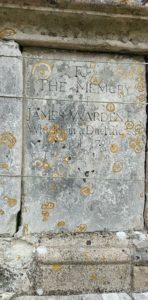
The lettering reads “To the Memory of James Warden Esq. who fell in a duel. The 28th April 1792 in the 56th year of his age.” The rope around the stone is a reminder of its precarious state. Photo taken 31 August 2023.
The words on the tomb were so weathered as to be largely indecipherable, thus, though I knelt on the ground and started to copy the very long inscription on the other side, it became too much for my one eye, and anyway, I gambled that someone else of like mind was bound to have done the work for me.
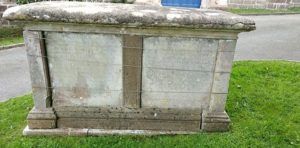
As it proved. I could not possibly compete with the amazing website I found when I got home which has everything you may need to know about the life and death of Warden, as well as “his sisters and his cousins and his aunts”.
In a nutshell, after a very distinguished career in the Royal Navy, in 1788 James Warden became Lord of the Manor of Charmouth by purchase. He died four years later in a ridiculous duel, fought against his neighbour, Norman Bond. Feelings became ruffled in 1792 when Warden sent Bond a harshly worded letter telling him to keep his dogs off his lands, otherwise he, Warden, would have them shot. Bond objected to the tone of the message and when the two men met on the road, threats were made, and the fateful challenge issued. The pig-headed affair reached its unhappy conclusion four days later at Hunter’s Cross when both participants took aim and fired. Warden’s bullet grazed the top of Bond’s hat, but Bond shot Warden in the stomach. Duelling was against the law and to avoid a charge of murder, Bond fled to Barbados, (a destination which seems to be following me about at present.)
But let’s go back a century earlier and the literal small fry of the infamous Monmouth Rebellion, and meet the fisherman, Samuel Robbins of Charmouth. With two others on board, he was out with his nets in Lyme Bay in June 1685 when Monmouth’s ships, Helderenberg, Pink and Dogger, loomed above them. They were forcibly taken on board, and their first thoughts must have been that they had come across pirates. Robbins, who like the others probably feared for his life, was not someone to turn down a likely opportunity. He was a businessman; he offered to sell them the catch. He knew nothing of Monmouth, who had to be pointed out to him. The Duke, who could surely have easily commandeered the fish with the flick of a lace cuff, was perhaps amused by the man’s sheer cheek. For a moment it may have broken the high tension of the mission. Maybe there was even a ripple of mirth. The Duke chose gallantry. Royalty do not carry money, even the bastard son of a king. He motioned to an underling and said something like “Pay the man!”
Unfortunately for Robbins, this was not the end of it. When they dropped anchor in the shallows, Sam, on a promise of his silence coupled with immediate freedom, rowed Monmouth and several of his lieutenants ashore. The fate of the other two fishermen is not known, however, one expects the worst.
I imagine that Robbins legged it to Charmouth as soon as his passengers disembarked. Home to break the news to his wife, that he had lost the boat, their means of subsistence. He gradually unfolded the story, which sounded far-fetched even to himself, though he had the foreign silver he had been paid for the fish to show for it. But, within hours the uprising was common knowledge and rapidly gathered pace. Enough Charmouth men and boys went missing to assume they had joined up with the rebels. Sam was never with them, but he was sensible enough to know that whether he had been paid in stuivers or guilders, he would never dare to pass the money, at least until after the crisis. But in the furore tongues wagged.
The Rebellion was over in just three weeks, between 11th June when Monmouth landed at Lyme Regis and the debacle at Sedgemoor on 6th July. Revenge against those not killed on the battlefield and the bloodletting of the aftermath, was swift and vicious. It is rightly known as “The Bloody Assize”.
The constables of each hundred through which the rebels had marched were instructed to investigate every village under their jurisdiction to discover which inhabitants were absent from home during the period of the rebellion. Sixteen men from Charmouth are named in various lists which amalgamated form “The Roll Call of the Rebels”. One of those arrested and charged with High Treason was Samuel Robbins on 14th July, in Lyme Regis.
Official details are sparse.
“He was taken at Lyme Regis on July 14. He was tried at Dorchester Sept. 10 and hanged at Wareham Sept. 22. He sold fish to Monmouth and so landed with him. A copy of the Solemn League and Covenant was found at his house.”[1]
Monmouth’s personal physician, Dr Benjamin Temple, one of the inner circle of conspirators rowed ashore by Samuel Robbins, made an impassioned speech at the scaffold where he himself would shortly die. Temple found it impossible to stay silent concerning the “small ground on which Robbins was found guilty”. A “grave injustice”, to a man “never more innocenter……who was murthered at Wareham”. “Proof” to his only “crime”, he said, was “alas, a Goode Booke, the Solemn League and Covenant” found at his house .[2] That this was “High Treason was aggravated (sic) to the Lord Chief Justice by one or two hot spirits, his neighbours,” when the rest would testify otherwise as to Robbins being a “zealous man, a Christian, a man of very good life and conversation”. After he received Sentence of Death he said “with great courage … ‘I am innocent of anything that I have done against any man that I deserve this punishment as a child unborn.’ When he came to the place of Execution he very cheerfully declared again his innocency to the spectators as before and so, praying devoutly for some time, he was executed.”
This report is found in “The Western Martyrology of the Bloody Assizes” by John Tutchin and repeated in full on the Freshford website (once again a superb endeavour)
I have a minor gripe. Temple could not have known Robbins’ brave conduct at the scaffold. According to the records, Temple was executed at Lyme Regis on 12th September, whereas Robbins was not hanged until 22 September at Wareham. [3]
What is undisputed is that each trial needed two witnesses to speak against the accused. There were so many in custody that it would have been too time-consuming to find sufficient witnesses in each case. To speed things up these people were encouraged to plead guilty “pretending if they would confess they would do them all the kindness they could at the assizes……it was such a piece of treachery to betray them of their lives. Some were terrified into confessing with hope of pardon and then hanged, whom otherwise they could have had little against.”[4] However, to stress the point that The King was eager to pardon rebels if they pleaded Guilty, Judge Jeffreys tried a batch of 30 rebels who pleaded their innocence. Twentynine were sentenced to death on 5th September, of whom 13 were hanged at Dorchester two days later. The terrible punishment for rebellion, too sickening to go into, was designed to strike terror into the hearts of the population, particularly the poor. The “quarters” of the executed were put on public display as so many joints of meat in every village of the West Country to which a suspected rebel belonged. Those who escaped with their lives received the sentence of transportation to the King’s territories in the West Indies and Virginia. Businessmen and gentry with plantations were allowed to make bids for them. They were worth about £10 or £15 apiece. The surnames of those transported can to this day be found in Barbados (again!) They received no gratuity when their time was served, and the only way most could hope to get home was through enlistment. Some settled. Barbadian families such the Austins claim direct descent from a Monmouth rebel, Thomas Austin, a Taunton mercer. Availability of records these days show others who also settled down in the island. Fifteen-year-old Enoch Gold, a weaver from Williton, who was sold to Major Abel Allen, married in Barbados in 1696 and made his will in 1720 as a “Merchant of Bridgetown”.
As to Samuel Robbins, I have found no baptism for him, but he could have been born sometime in the 1640s. He may have been the Samuel Robins who married Jane Henley at Lyme Regis on 3 October 1666, so he was probably in his middle forties when misfortune found him. Jane, his widow, was buried at Charmouth as “Jone Robins” on 25 July 1687. A broken heart? Possibly. Certainly broken. Perhaps ostracised, rendered untouchable, by the taint of the events of 1685. Samuel and Jane may have had a daughter, Phoebe, who married George Street at Lyme Regis in March 1688. So now I close the chapter in hope that Phoebe and George went on to have happy lives.
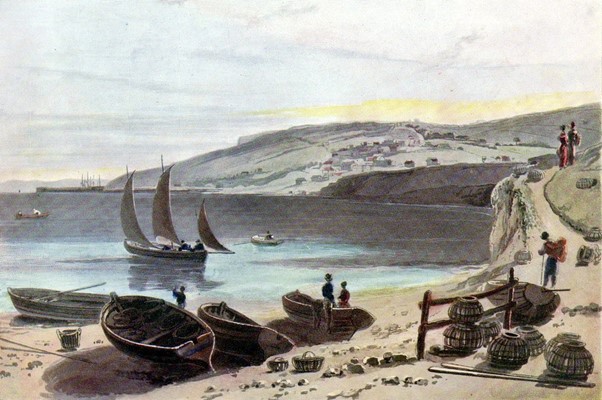
Aquatint of Lyme Regis from Charmouth Beach by William Daniell, R.A. The Charmouth end of the lane which ran along the edge of the cliffs for the whole distance between Lyme and Charmouth is shown. The Lyme end is marked by Church Street today.
[1] “The Monmouth Rebels” W. McD. Wigfield, which lists the sources.
[2] Solemn League and Covenant, (1643), agreement between the English and Scots by which the Scots agreed to support the English Parliamentarians in their disputes with Royalists.
[3] Wigfield, ibid
[4] John Whiting, a Quaker prisoner at Ilchester, quoted Wigfield.


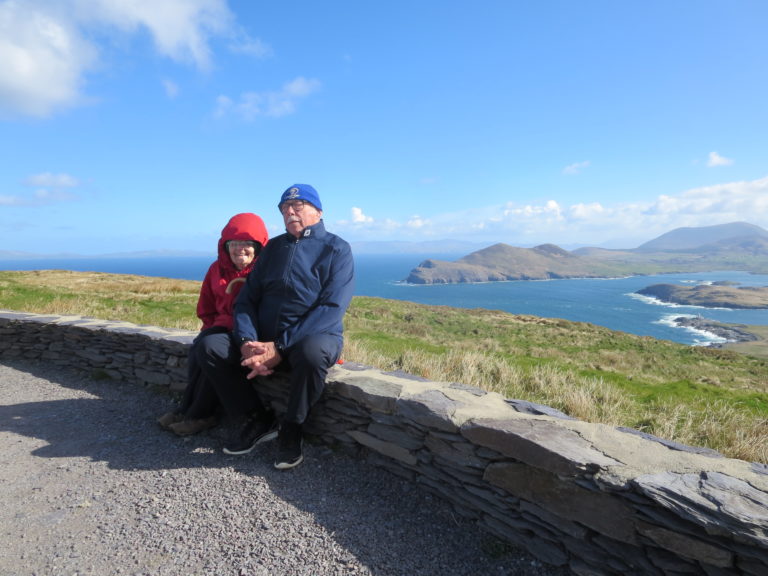
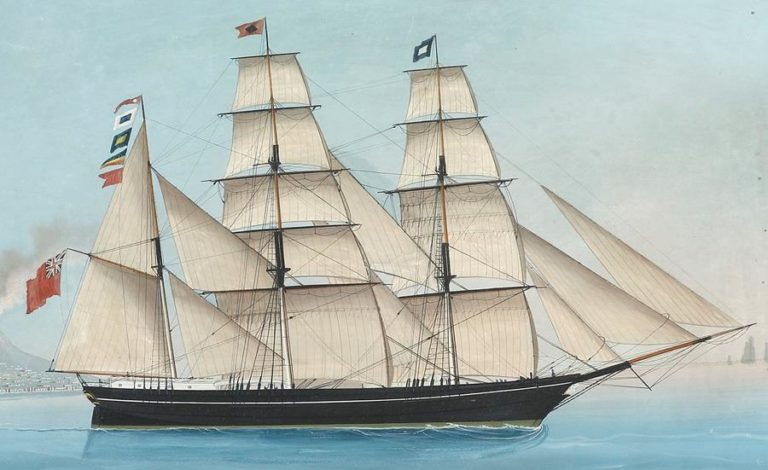





Blog Comments
Gary Hynard
18th September 2023 at 3:19 pm
Hi DP
I recently acquired a Victorian Photograph Album that belonged to a George Edward Sheward Cartwright, the son of George Leopold Cartwright from Brislington. I’m just starting to research and write up a life story for each individual person in the album, there are 175 photographs in the album, most are named, so l have a big job on my hands.
Researching the Reverend George L Cartwright, l see that you have him on your website, and wondered if you would like to see him and his family, to put a face to the words so to speak. So far l have uncovered some really interesting facts about the family, and a scandal involving the son George E S Cartwright.
If so, just drop me an email and I’ll send you some pictures.
Gary Hynard
dp lindegaard
18th September 2023 at 4:53 pm
Dear Gary
What a fantastic offer. Thanks. I would be very pleased to see the Cartwright photos!
Simon Parsons
13th February 2024 at 1:14 pm
The duel between Warden and Bond was fought at Hunters Lodge. The pistols were actually supplied by Warden’s wife! Warden was shot in the heart not the stomach.
For much more information on Charmouth, see http://www.freshford.com